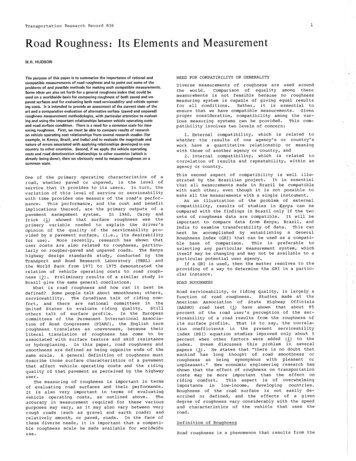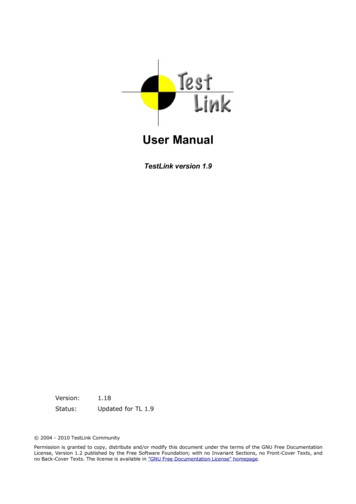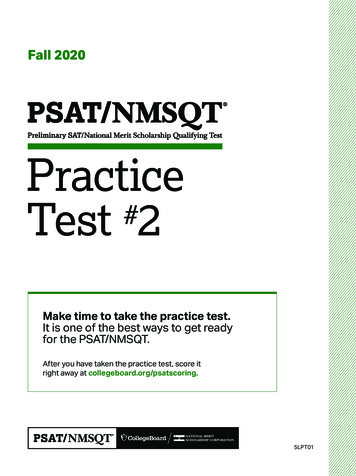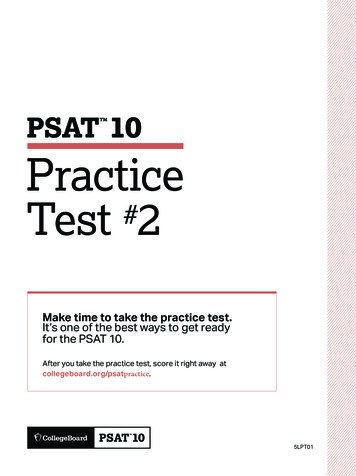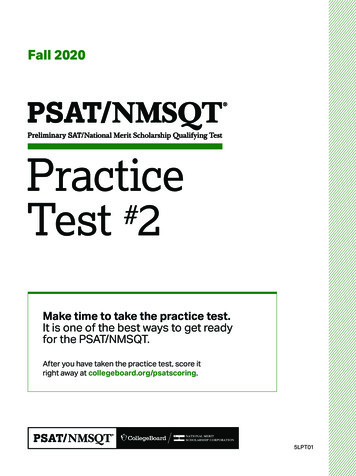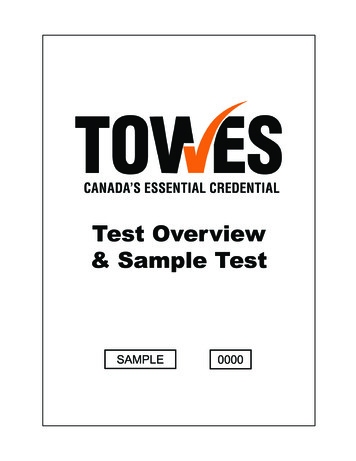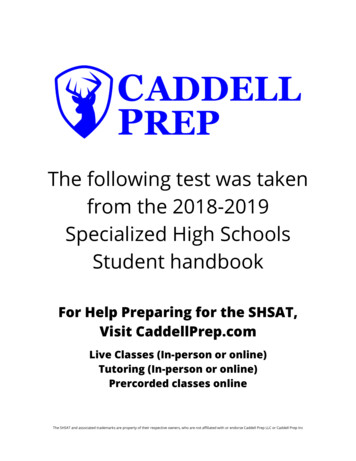
Transcription
The following test was takenfrom the 2018-2019Specialized High SchoolsStudent handbookFor Help Preparing for the SHSAT,Visit CaddellPrep.comLive Classes (In-person or online)Tutoring (In-person or online)Prercorded classes onlineThe SHSAT and associated trademarks are property of their respective owners, who are not affiliated with or endorse Caddell Prep LLC or Caddell Prep Inc
BGRADE 8NEW YORK CITY PUBLIC SCHOOLS2018 Specialized High SchoolsADMISSIONS TESTGENERAL DIRECTIONSIdentifying InformationTurn to Side 1 of the answer sheet. Line 1 says, “I amwell enough to take this test and complete it. I understand that once I break the seal of the test booklet, I maynot be eligible for a make-up test. I am a New York Cityresident and a Grade 8 student taking a Grade 8 test.I understand that a student who is not a New York Cityresident, who takes the test more than once in a givenschool year, or who takes the test at the wrong grade levelwill be disqualified from acceptance to any of thespecialized high schools.” Sign your name in the spacefollowing the word “signature.” Do not print your name.Notify the proctor immediately if you are ill orshould not be taking this test. Do not sign thestatement or begin the test. Return your answersheet to the proctor.On Line 2, print today’s date, using the numbers of themonth, the day, and the year. On Line 3, print your birthdate with the number of the month first, then the numberof the day, then the last two digits of the year. Forexample, a birth date of March 1, 2004, would be 3-1-04.In Grid 4, print the letters of your first name, or as manyas will fit, in the boxes. Write your name exactly as youdid on the application. If you have a middle initial, print itin the box labeled “MI.” Then print the letters of your lastname, or as much as will fit, in the boxes provided. Beloweach box, fill in the circle that contains the same letter asthe box. If there is a space or a hyphen in your name, fillin the circle under the appropriate blank or hyphen.Make dark marks that completely fill the circles.If you change a mark, be sure to erase the first markcompletely.Fill in one and only one circle for each school forwhich you wish to be considered. You may makeas few as one or as many as eight choices. To increaseyour chances of being assigned to one of the specializedhigh schools, you are encouraged to make more than onechoice. You must fill in a first choice school. Do not fillin a school more than once. Do not fill in the same schoolfor each choice. Fill in only one circle in a row and onlyone circle in a column.Grid 6 asks for your date of birth. Print the first threeletters of the month in the first box, the number of theday in the next box, and the year in the last box. Thenfill in the corresponding circles.In Grid 7:1. Print the name of the school where you are nowenrolled in the space at the top of the grid.2. In the boxes marked “SCHOOL CODE,” print the sixdigit code that identifies your school and fill in thecircle under the corresponding number or letter foreach digit of the school code. (You can find your schoolcode on your Test Ticket. If it is not there, tell theproctor, and the proctor will get the school code foryou.)3. If you attend a private or parochial school, fill inthe circle marked “P.”Grid 8 is labeled “STUDENT ID NUMBER.” All testtakers should print their student ID number in Grid 8.The student ID number is found on your Test Ticket. Inthe boxes, print your nine-digit student ID number. Beloweach box, fill in the circle containing the same number asin the box.Grid 5 is for your choice of specialized high schools.If Grid 5 is not marked correctly, your admission to aspecialized high school will be affected because youradmission is based on the score you achieve and theorder in which you rank your school preferences in thisgrid. The school choices indicated on your answer sheetare final. Therefore, carefully copy the order in which youranked the schools on your Test Ticket onto Grid 5.Form B114DO NOT OPEN THIS BOOKLETUNTIL YOU ARE TOLD TO DO SOTURN YOUR BOOKLET OVER TO THE BACK COVERCONTINUE ON TO THE NEXT PAGE
GENERAL DIRECTIONS,continuedIdentifying Information, continuedGrid 9 is labeled “BOOKLET LETTER AND NUMBER.” In most cases, Grid 9 is already filled in for you. If it is not,copy the letter and numbers shown in the upper-right corner of your test booklet into the boxes. Below each box, fill inthe circle containing the same letter or number as the box.Now review Side 1 to make sure you have completed all lines and grids correctly. Review each column to see that thefilled-in circles correspond to the letters or numbers in the boxes above them.Turn your answer sheet to Side 2. Print your test booklet letter and numbers, and your name, first name first, in thespaces provided.Marking Your AnswersMark each of your answers on the answer sheet in the row of circles corresponding to the question number printed inthe test booklet. Use only a Number 2 pencil. If you change an answer, be sure to erase it completely. Be careful toavoid making any stray pencil marks on your answer sheet. Each question has only one correct answer. If you markmore than one circle in any answer row, that question will be scored as incorrect. See the example of correct andincorrect answer marks below.SAMPLE ANSWER You can use your test booklet or the provided scrap paper to take notes or solve questions; however youranswers must be recorded on the answer sheet in order to be counted. You will not be able to mark youranswers on the answer sheet after time is up, and answers left in the test booklet will not be scored.DO NOT MAKE ANY MARKS ON YOUR ANSWER SHEET OTHER THAN FILLING IN YOUR ANSWERCHOICES.Planning Your TimeYou have 180 minutes to complete the entire test. How you allot the time between the English Language Arts andMathematics sections is up to you. If you begin with the English Language Arts section, you may go on to theMathematics section as soon as you are ready. Likewise, if you begin with the Mathematics section, youmay go on to the English Language Arts section as soon as you are ready. If you complete the test before theallotted time (180 minutes) is over, you may go back to review questions in either section.Be sure to read the directions for each section carefully. Each question has only one correct answer. Choose the bestanswer for each question. When you finish a question, go on to the next, until you have completed the last question.Your score is determined by the number of questions you answer correctly. Answer every question, even if youmay not be certain which answer is correct. Don’t spend too much time on a difficult question. Come back to itlater if you have time. If time remains, you should check your answers.Students must stay for the entire test session.DO NOT OPEN THIS BOOKLET UNTIL YOU ARE TOLD TO DO SOCopyright 2018 Pearson. All rights reserved.No part of this document may be copied, reproduced, modified, or transmitted by any means,electronic or mechanical.Form BBNYC0000123411127971151 2 3 4 5 A B C D EPrinted in the USAISD17604CONTINUE ON TO THE NEXT PAGE
SAMPLE TEST, FORM BPART 1 — ENGLISH LANGUAGE ARTS57 QUESTIONSREVISING/EDITINGQUESTIONS 1–9IMPORTANT NOTEThe Revising/Editing section (Questions 1-9) is in two parts: Part A and Part B.REVISING/EDITING Part ADIRECTIONS: Read and answer the following questions. You will be asked to recognize and correct errorsso that the sentences or short paragraphs follow the conventions of standard written English. You maywrite in your test booklet as needed to take notes. You should re-read relevant parts of the sentences orparagraphs before marking the best answer for each question.1.Read this sentence.The Colosseum in Rome, Italy which is considered one of the “new” Seven Wonders of the World,is the largest amphitheater ever built and could hold more than 50,000 spectators.Which edit should be made to correct the sentence?A. Delete the comma after Rome.B. Insert a comma after Italy.C. Delete the comma after World.D. Insert a comma after built.Form B116CONTINUE ON TO THE NEXT PAGE
2.Read this paragraph.In September 2016 the National Museum of African American History and Culture opened aspart of the Smithsonian Institution, the museum is already the Smithsonian’s third mostpopular site. Experts say that they expect this newest Smithsonian facility to welcome nearly4 million visitors a year. The museum features more than 30,000 objects, including MuhammadAli’s boxing gloves and a dress sewn by Rosa Parks. A commemorative copy of the EmancipationProclamation, written in 1863 during the presidency of Abraham Lincoln, is also on display atthe museum.Which revision corrects the error in sentence structure in the paragraph?E. Institution, and theF. year, and theG. objects, which includeH. Proclamation, which was written3.Read this sentence.To promote their club, a bake sale will be sponsored by members of the debate team onWednesday.How should the sentence be revised?A. To promote their club, on Wednesday a bake sale will be sponsored by members of thedebate team.B. On Wednesday to promote their club, a bake sale will be sponsored by members of thedebate team.C. To promote their club, members of the debate team will sponsor a bake sale on Wednesday.D. Members of the debate team, on Wednesday to promote their club, will sponsor a bake sale.Form B117CONTINUE ON TO THE NEXT PAGE
4.Read this paragraph.(1) Devon spent several hours preparing for an upcoming audition for a play at the communitytheater. (2) First he did vocal exercises to practice his diction and projection so that his wordswould carry clearly throughout the large auditorium. (3) Then he studies the text of themonologue to better understand the emotions, and motivations of the character he plans toportray. (4) Finally he recited his monologue in front of a mirror many times, making slightadjustments and improvements to his performance each time.How should the paragraph be revised?E. Sentence 1: Change spent to had spent, AND insert a comma after play.F. Sentence 2: Change did to does, AND insert a comma after projection.G. Sentence 3: Change studies to studied, AND delete the comma after emotions.H. Sentence 4: Change recited to recites, AND delete the comma after times.Form B118CONTINUE ON TO THE NEXT PAGE
CONTINUE ON TO THE NEXT PAGE cForm B119CONTINUE ON TO THE NEXT PAGE
REVISING/EDITING Part BDIRECTIONS: Read the text below and answer the questions following it. You will be asked to improvethe writing quality of the text and to correct errors so that the text follows the conventions of standardwritten English. You should re-read relevant parts of the text before marking the best answer for eachquestion.The Local Library(1) According to a 2015 survey, more than two-thirds of Americans own a smartphone, which means thatobtaining information or communicating with people is easier than ever before. (2) With the swipe of afinger, the tap of an icon, or a verbal command, people have instant access to articles, blogs, news, andsocial networking websites. (3) Even with all these immediately available sources of information, one ofthe best resources for many members of the community also happens to be one of the oldest. (4) Thepublic library is a great place for people to get information.(5) The public library serves a truly critical role in promoting community. (6) With the explosion ofdigital media in recent years, people in different locations can now communicate almostinstantaneously. (7) And yet many people complain of feeling more isolated and alone than everbefore. (8) The library stands in a rare position to help community members meet this universal need forhuman connection and companionship.(9) Furthermore, libraries provide certain amenities, such as access to the Internet, for free to allpeople. (10) A student who does not have a computer at home can research and type a paper forschool. (11) Similarly, an unemployed adult without access to the Internet can make use of libraryresources to find job opportunities. (12) The free items that are found at the library can help people get alot done.(13) Public libraries also offer a variety of resources to community members. (14) One importantresource is the local librarian, who does far more than check out books and collect fines. (15) Otherlibrary resources include free or low-cost tutoring and training programs. (16) Additionally, lectures,book groups, and town meetings promote critical thinking and community engagement. (17) A typicallibrarian holds a master’s degree and can help library patrons navigate through the flood of informationavailable in print and on the Internet.(18) The hallmark of a public library is that its materials and services are accessible to all. (19) Thelibrary connects people to a network of information and resources and is an important part ofa community.Form B120CONTINUE ON TO THE NEXT PAGE
5.Which sentence should replace sentence 4 to best introduce the main claim of the passage?A. In this age of smartphones and search engines, the public library is a valuable resource that allmembers of a community should use.B. Finding information is easier than ever, but going to the public library is still a valuablelearning experience.C. Though today’s computers are highly advanced, the resources available at a public library aremore useful for students.D. Despite the proliferation of social networking sites, a public library is a great place for people whoare interested in improving their community.6.Which sentence would best follow and support sentence 8?E. Libraries, which have been around for centuries and are found throughout the world today, helppreserve the history of a community.F. The public library is often used as a place for community leaders and organizers to hostcommunity events, such as hearings or town halls.G. Libraries rely on a combination of local, state, and federal dollars to provide the kinds of servicesand programs that community members have come to expect.H. At a public library, people can interact with others through a variety of programs, including teenbook clubs, toddler story times, and senior-citizen exercise classes.7.Which revision of sentence 12 best maintains the formal style established in the passage?A. The free resources available at the library can help people accomplish many tasks.B. All the free materials you can get at the library can help you do many different tasks.C. Everything that is free at the library can help people work on a lot of different things.D. The free resources you can find at the library can help you do whatever you need to do.Form B121CONTINUE ON TO THE NEXT PAGE
8.Where should sentence 17 be moved in order to improve the organization of the fourth paragraph(sentences 13–17)?E. to the beginning of the paragraph (before sentence 13)F. between sentences 13 and 14G. between sentences 14 and 15H. between sentences 15 and 169.Which concluding sentence should be added after sentence 19 to support the argument presented inthe passage?A. Therefore, patrons of the public library can grow in both their social life and their level ofcommunity engagement.B. Clearly, it is in the best interest of community members to maintain, support, and use theirpublic library.C. After all, the public library has been a part of American communities since the first library wasfounded in 1833.D. In fact, community leaders must work together to find ways to generate more involvement inevents at the public library.Form B122CONTINUE ON TO THE NEXT PAGE
READING COMPREHENSIONQUESTIONS 10–57DIRECTIONS: Read each of the following six texts, and answer the related questions. You may write inyour test booklet as needed to take notes. You should re-read relevant parts of each text before markingthe best answer for each question. Base your answers only on the content within the text.CONTINUE ON TO THE NEXT PAGE cForm B123CONTINUE ON TO THE NEXT PAGE
The Tunguska Fireball123456On June 30, 1908, an enormous fireball shot across the sky and exploded high above the remoteTunguska River Valley in the Siberian region of Russia. Twenty miles away, huts were flattened andpeople were flung into the air. Villagers 40 miles away felt the heat and heard explosions, and tremorswere recorded at a German seismic station more than 3,000 miles away.What caused the intense light and the horrendous destruction of the Tunguska Fireball, as it came tobe called? Scientists and laypeople have debated the question for over 100 years. Not until 1927 did ascientific expedition, led by Russian scientist Leonid Kulik, reach the remote site. Kulik discovered avast region of scorched and downed trees, their trunks pointing away from the center of the blast.Convinced that a meteorite was responsible, Kulik searched for evidence—a crater, a buried meteorite,even fragments of the exploded mass. He never found it.Other scientists, amateur astronomers, and the public suggested alternative theories of what hadhappened. Some thought it was an earthquake. Perhaps, others said, a black hole—a theoretical objectin space where gravity is so strong that even light cannot get out—had collided with Earth or an alienspaceship carrying nuclear material had crashed.For many years Russian scientists believed that the Tunguska Fireball was a comet—a cluster of dustand frozen gases—that had exploded a few hundred feet above the ground. They pointed to the lack ofmeteoric evidence and the June 30 date, a time of year when Earth was passing through cometarydebris. Other scientists disagreed, arguing that a comet would have burned quickly in Earth’satmosphere and could not have created such a blast.Many Western scientists believed that a meteorite was responsible, despite the lack of evidence. Thepattern of fallen trees suggested that they were knocked down by a blast about 4 miles above theground with an energy of 15 megatons of TNT, consistent with a meteoric blast. Yet repeated searchesof the surrounding forest and wetlands revealed no evidence of a meteorite.During the 1990s an Italian physicist named Menotti Galli became interested. Galli had previouslyinvestigated whether particles from outer space can add carbon atoms to the cellulose in trees.Perhaps the trees at the Tunguska site hid evidence of such extraterrestrial material. Galli and hiscolleagues traveled to the site by helicopter to gather core samples from spruce trees that had livedthrough the blast. They analyzed the particles trapped in the trees’ resin, and the results wereremarkable. Based on studying the trees’ rings during the time period when the Tunguska Fireballoccurred, the researchers found that the resin contained high levels of high-proton elements, such ascopper, gold, and nickel. In fact, it contained ten times more such particles than resin dating fromeither before or after that time period. Some previously discovered meteorites had also containedelevated levels of these elements, suggesting that the particles had an extra-earthly origin.But then where is the crater? Is it nearby Lake Cheka, as some claim? Or was the meteorite reducedto dust in the atmosphere? Can scientists rule out a comet carrying those elements? The mysteryremains unsolved.Form B124CONTINUE ON TO THE NEXT PAGE
10. What evidence best indicated the location of the blast?E. a lake formed from a craterF. tremors recorded at a seismic stationG. damage caused to buildingsH. the position of the trunks of fallen trees11. The June 30 date of the Tunguska event was significant to some scientists because itA. suggested that the explosion may have been caused by a comet.B. highlighted why tree resin from the time of the blast contained high-proton elements.C. indicated that the blast may have resulted from Earth’s impact with a black hole.D. explained why debris from outer space would have burned up in the atmosphere.12. What did Galli’s analysis of tree resin at the site reveal?E. Certain elements were unusually abundant around the time of the blast.F. Particles from outer space can add carbon atoms to trees.G. Spruce trees were able to survive the Tunguska explosion.H. Meteorites are composed of gold, copper, and other high-proton elements.13. Based on the passage, what is the most likely reason it took nineteen years from the date of theexplosion before scientists first visited the Tunguska site?A. The scientists feared radioactivity from a nuclear explosion.B. The site was far from civilization and difficult to reach.C. Scientists hoped to establish a cause before exploring the site.D. Craters from the explosion hampered travel to the area.Form B125CONTINUE ON TO THE NEXT PAGE
14. What is the primary role of paragraph 1 in the structure of the passage?E. It explains the scientific importance of the explosion.F. It indicates the magnitude of the explosion.G. It provides possible causes of the explosion.H. It describes the human suffering caused by the explosion.15. The author includes a series of questions at the end of the last paragraph most likely toA. encourage further study of the Tunguska event.B. suggest that the Tunguska event had multiple causes.C. reflect a personal curiosity about the Tunguska event.D. emphasize that the Tunguska event has not yet been fully explained.Form B126CONTINUE ON TO THE NEXT PAGE
CONTINUE ON TO THE NEXT PAGE cForm B127CONTINUE ON TO THE NEXT PAGE
Excerpt from A Voice in the Wildernessby Grace Livingston Hill1With a lurch the train came to a dead stop and Margaret Earle, hastily gathering up her belongings,hurried down the aisle and got out into the night.2It occurred to her, as she swung her heavy suit-case down the rather long step to the ground, and thencarefully swung herself after it, that it was strange that neither conductor, brakeman, nor porter hadcome to help her off the train, when all three had taken the trouble to tell her that hers was the nextstation; but she could hear voices up ahead. Perhaps something was the matter with the engine thatdetained them and they had forgotten her for the moment.3The ground was rough where she stood, and there seemed no sign of a platform. Did they not haveplatforms in this wild Western land, or was the train so long that her car had stopped beforereaching it?45678She strained her eyes into the darkness, and tried to make out things from the two or three specks oflight that danced about like fireflies in the distance. She could dimly see moving figures away up nearthe engine, and each one evidently carried a lantern. The train was tremendously long. A suddenfeeling of isolation took possession of her. Perhaps she ought not to have got out until some one cameto help her. Perhaps the train had not pulled into the station yet and she ought to get back on it andwait. Yet if the train started before she found the conductor she might be carried on somewhere and hejustly blame her for a fool.There did not seem to be any building on that side of the track. It was probably on the other, but shewas standing too near the cars to see over. She tried to move back to look, but the ground sloped andshe slipped and fell in the cinders,1 bruising her knee and cutting her wrist.In sudden panic she arose. She would get back into the train, no matter what the consequences. Theyhad no right to put her out here, away off from the station, at night, in a strange country. If the trainstarted before she could find the conductor she would tell him that he must back it up again and lether off. He certainly could not expect her to get out like this.She lifted the heavy suit-case up the high step that was even farther from the ground than it had beenwhen she came down, because her fall had loosened some of the earth and caused it to slide away fromthe track. Then, reaching to the rail of the step, she tried to pull herself up, but as she did so theengine gave a long snort and the whole train, as if it were in league against her, lurched forwardcrazily, shaking off her hold. She slipped to her knees again, the suit-case, toppled from the lower step,descending upon her, and together they slid and rolled down the short bank, while the train . . . rangiddily off into the night.The horror of being deserted helped the girl to rise in spite of bruises and shock. She lifted imploringhands to the unresponsive cars as they hurried by her—one, two, three, with bright windows, eachshowing a passenger, comfortable and safe inside, unconscious of her need.1cinders:Form Btrack bed made from the residue of burnt coal128CONTINUE ON TO THE NEXT PAGE
9A moment of useless screaming, running, trying to attract some one’s attention, a sickening sense ofterror and failure, and the last car slatted itself past with a mocking clatter, as if it enjoyedher discomfort.10Margaret stood dazed, reaching out helpless hands, then dropped them at her sides and gazed afterthe fast-retreating train, the light on its last car swinging tauntingly, blinking now and then with aleer in its eye, rapidly vanishing from her sight into the depth of the night.11She gasped and looked about her for the station that but a short moment before had been so real toher mind; and, lo! on this side and on that there was none!12The night was wide like a great floor shut in by a low, vast dome of curving blue set with the largest,most wonderful stars she had ever seen. Heavy shadows of purple-green, smoke-like, hovered overearth darker and more intense than the unfathomable blue of the night sky. It seemed like the secretnesting-place of mysteries wherein no human foot might dare intrude. It was incredible that suchcould be but common sage-brush, sand, and greasewood wrapped about with the beauty of thelonely night.13No building broke the inky outlines of the plain, nor friendly light streamed out to cheer her heart.Not even a tree was in sight, except on the far horizon, where a heavy line of deeper darkness mightmean a forest. Nothing, absolutely nothing, in the blue, deep, starry dome above and the bluerdarkness of the earth below save one sharp shaft ahead like a black mast throwing out a dark armacross the track.14As soon as she sighted it she picked up her baggage and made her painful way toward it, for her kneesand wrist were bruised and her baggage was heavy.15A soft drip, drip greeted her as she drew nearer; something plashing down among the cinders bythe track. Then she saw the tall column with its arm outstretched, and looming darker among thesage-brush the outlines of a water-tank. It was so she recognized the engine’s drinking-tank, and knewthat she had mistaken a pause to water the engine for a regular stop at a station.From A VOICE IN THE WILDERNESS by Grace Livingston Hill—Public Domain16. In paragraph 2, how does the phrase “when all three had taken the trouble to tell her” affect the tonein the first part of the excerpt?E. It creates an accusatory tone by suggesting that Margaret believes that others are responsible forher problem.F. It introduces a defiant tone by suggesting that Margaret left the train early to prove a point.G. It suggests a frustrated tone by showing that Margaret feels confused by the inconsistent helpoffered by the railroad employees.H. It establishes an appreciative tone by showing that Margaret feels cared for by therailroad employees.Form B129CONTINUE ON TO THE NEXT PAGE
17. Which sentence from the excerpt best supports the idea that traveling to new places by train isunfamiliar to Margaret?A. “With a lurch the train came to a dead stop and Margaret Earle, hastily gathering up herbelongings, hurried down the aisle and got out into the night.” (paragraph 1)B. “Perhaps something was the matter with the engine that detained them and they had forgottenher for the moment.” (paragraph 2)C. “Did they not have platforms in this wild Western land, or was the train so long that her car hadstopped before reaching it?” (paragraph 3)D. “She could dimly see moving figures away up near the engine, and each one evidently carried alantern.” (paragraph 4)18. Read this sentence from paragraph 4.Yet if the train started before she found the conductor she might be carried onsomewhere and he justly blame her for a fool.How does the sentence contribute to the development of the plot?E. It shows how Margaret’s reliance on the guidance of others leads to the external conflictshe faces.F. It reveals how Margaret’s concern about the opinions of others causes the external conflictshe faces.G. It highlights how Margaret’s indecision results in the external conflict being prolonged.H. It illustrates how Margaret’s confusion makes it difficult for her to fully understand theexternal conflict.19. Read this sentence from paragraph 4.She strained her eyes into the darkness, and tried to make out things from the two orthree specks of light that danced about like fireflies in the distance.The simile used in the sentence affects the tone of the paragraph by emphasizing aA. feeling of comfort as Margaret connects her unfamiliar surroundings with familiar images.B. sense of lonesomeness as Margaret realizes that she is on her own in the wilderness.C. sense of tranquility as Margaret is distracted from the urgency of her situation by the beauty ofthe night.D. feeling of dread as Margaret regards the desolation of the land that surrounds her.Form B130CONTINUE ON TO THE NEXT PAGE
20. Read paragraph 9 from the excerpt.A moment of useless screaming, running, trying to attract some one’s attention, asickening sense of terror and failure, and the last car slatted itself past with amocking clatter, as if it enjoyed her discomfort.The imagery in this sentence conveys theE. growing irritation Margaret feels as she is ignored by people on the train.F. effort Margaret is making despite being physically unable to keep up with the train.G. anger that Margaret is experi
code on your Test Ticket. If it is not there, tell the proctor, and the proctor will get the school code for you. If you attend a priate or parochial school, fill in the circle marked "." Grid 8 is labeled "STNT I N." ll test-takers should print their student I number in rid . The student I number is found on your Test Ticket. In


